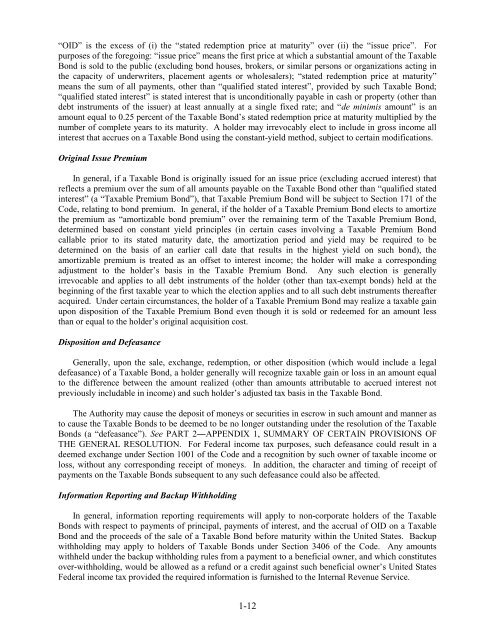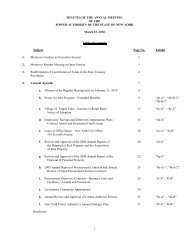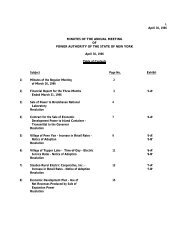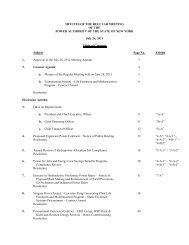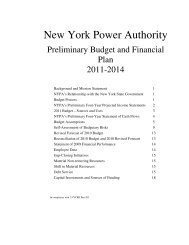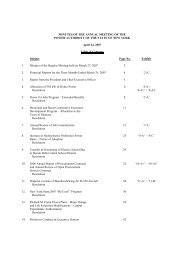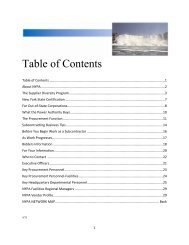July (pdf) - New York Power Authority
July (pdf) - New York Power Authority
July (pdf) - New York Power Authority
You also want an ePaper? Increase the reach of your titles
YUMPU automatically turns print PDFs into web optimized ePapers that Google loves.
“OID” is the excess of (i) the “stated redemption price at maturity” over (ii) the “issue price”. For<br />
purposes of the foregoing: “issue price” means the first price at which a substantial amount of the Taxable<br />
Bond is sold to the public (excluding bond houses, brokers, or similar persons or organizations acting in<br />
the capacity of underwriters, placement agents or wholesalers); “stated redemption price at maturity”<br />
means the sum of all payments, other than “qualified stated interest”, provided by such Taxable Bond;<br />
“qualified stated interest” is stated interest that is unconditionally payable in cash or property (other than<br />
debt instruments of the issuer) at least annually at a single fixed rate; and “de minimis amount” is an<br />
amount equal to 0.25 percent of the Taxable Bond’s stated redemption price at maturity multiplied by the<br />
number of complete years to its maturity. A holder may irrevocably elect to include in gross income all<br />
interest that accrues on a Taxable Bond using the constant-yield method, subject to certain modifications.<br />
Original Issue Premium<br />
In general, if a Taxable Bond is originally issued for an issue price (excluding accrued interest) that<br />
reflects a premium over the sum of all amounts payable on the Taxable Bond other than “qualified stated<br />
interest” (a “Taxable Premium Bond”), that Taxable Premium Bond will be subject to Section 171 of the<br />
Code, relating to bond premium. In general, if the holder of a Taxable Premium Bond elects to amortize<br />
the premium as “amortizable bond premium” over the remaining term of the Taxable Premium Bond,<br />
determined based on constant yield principles (in certain cases involving a Taxable Premium Bond<br />
callable prior to its stated maturity date, the amortization period and yield may be required to be<br />
determined on the basis of an earlier call date that results in the highest yield on such bond), the<br />
amortizable premium is treated as an offset to interest income; the holder will make a corresponding<br />
adjustment to the holder’s basis in the Taxable Premium Bond. Any such election is generally<br />
irrevocable and applies to all debt instruments of the holder (other than tax-exempt bonds) held at the<br />
beginning of the first taxable year to which the election applies and to all such debt instruments thereafter<br />
acquired. Under certain circumstances, the holder of a Taxable Premium Bond may realize a taxable gain<br />
upon disposition of the Taxable Premium Bond even though it is sold or redeemed for an amount less<br />
than or equal to the holder’s original acquisition cost.<br />
Disposition and Defeasance<br />
Generally, upon the sale, exchange, redemption, or other disposition (which would include a legal<br />
defeasance) of a Taxable Bond, a holder generally will recognize taxable gain or loss in an amount equal<br />
to the difference between the amount realized (other than amounts attributable to accrued interest not<br />
previously includable in income) and such holder’s adjusted tax basis in the Taxable Bond.<br />
The <strong>Authority</strong> may cause the deposit of moneys or securities in escrow in such amount and manner as<br />
to cause the Taxable Bonds to be deemed to be no longer outstanding under the resolution of the Taxable<br />
Bonds (a “defeasance”). See PART 2―APPENDIX 1, SUMMARY OF CERTAIN PROVISIONS OF<br />
THE GENERAL RESOLUTION. For Federal income tax purposes, such defeasance could result in a<br />
deemed exchange under Section 1001 of the Code and a recognition by such owner of taxable income or<br />
loss, without any corresponding receipt of moneys. In addition, the character and timing of receipt of<br />
payments on the Taxable Bonds subsequent to any such defeasance could also be affected.<br />
Information Reporting and Backup Withholding<br />
In general, information reporting requirements will apply to non-corporate holders of the Taxable<br />
Bonds with respect to payments of principal, payments of interest, and the accrual of OID on a Taxable<br />
Bond and the proceeds of the sale of a Taxable Bond before maturity within the United States. Backup<br />
withholding may apply to holders of Taxable Bonds under Section 3406 of the Code. Any amounts<br />
withheld under the backup withholding rules from a payment to a beneficial owner, and which constitutes<br />
over-withholding, would be allowed as a refund or a credit against such beneficial owner’s United States<br />
Federal income tax provided the required information is furnished to the Internal Revenue Service.<br />
1-12


